Insurrection Day: when white supremacist terror came to the US Capitol

If there was one single moment when the veil of American resilience crumbled and the Trumpist assault on democracy turned into an invasion, it arrived just before 1pm on Wednesday.
That was when a group of pro-Trump militants burst through a flimsy outer barrier on the north-west side of the Capitol building and advanced on a secondary barricade guarded by four frightened police officers, dressed only in basic uniforms and soft caps.
Related: US Capitol attack: Trump at bay as first Republican senator calls for resignation
One of the officers can be seen resting his hands on the barrier in as casual a manner he can manage, in an attempt to defuse the confrontation. He clearly had no idea what was coming.
On the other side, a young man in a white hoodie and a red Make America Great Again cap, pulls at the metal barricade but it holds. Then an older man, also red-capped but in full military uniform, takes the youth by the shoulder and whispers something in his ear as the swelling crowd around them chants “USA”.
Ten seconds later, the crowd pushes together, the metal fortification collapses, and the Capitol police officers are overwhelmed. The crowd surges past rushing towards the great white domed building atop Capitol Hill.
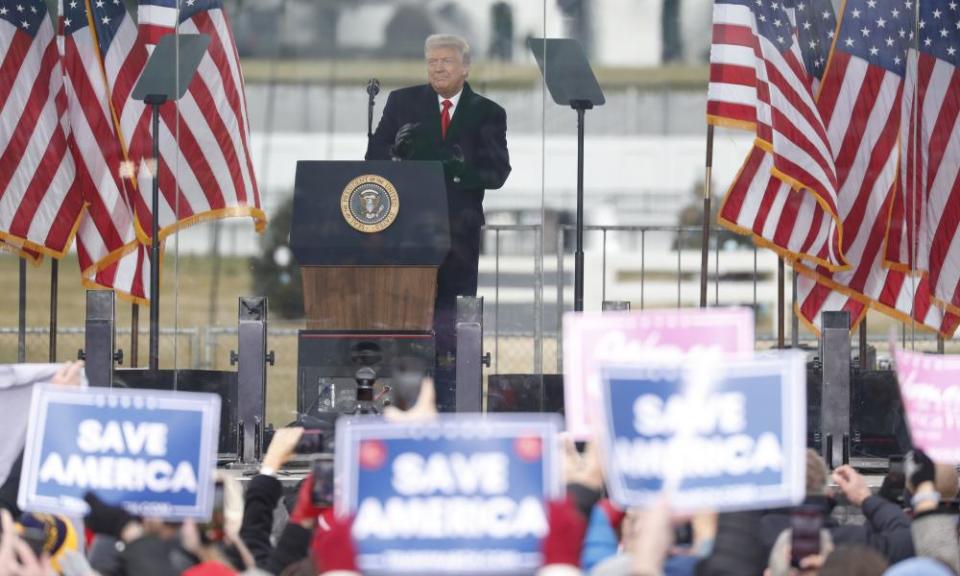
The protest has turned into an insurrection, breaching the home of US democracy, for the first time since the British army set it on fire in 1814.
Even those who had warned in vain of the Trump crowd’s criminal intent were stunned at how quickly the nation’s defences buckled. This was America’s “shining city upon a hill” but only the thinnest blue line was there to guard it at the crucial hour.
It later turned out that the Capitol police had turned down offers of support from the national guard, only calling for reinforcements when it was too late. The plan was to act as relaxed and low-key as possible, presumably so as not to irritate the crowd.
The contrast with the mass deployments of over 5,000 troops for the Black Lives Matter protests in the summer could not have been more glaring. Then, Washington resembled a city under occupation.
On Wednesday, it was close to defenceless.
This appeared to be deliberate, at least in part. Donald Trump was not about to let the federal government go to war with “his people”, who he had invited to the nation’s capital in a last-ditch effort to reverse his emphatic election defeat, due to be certified by Congress on Wednesday.
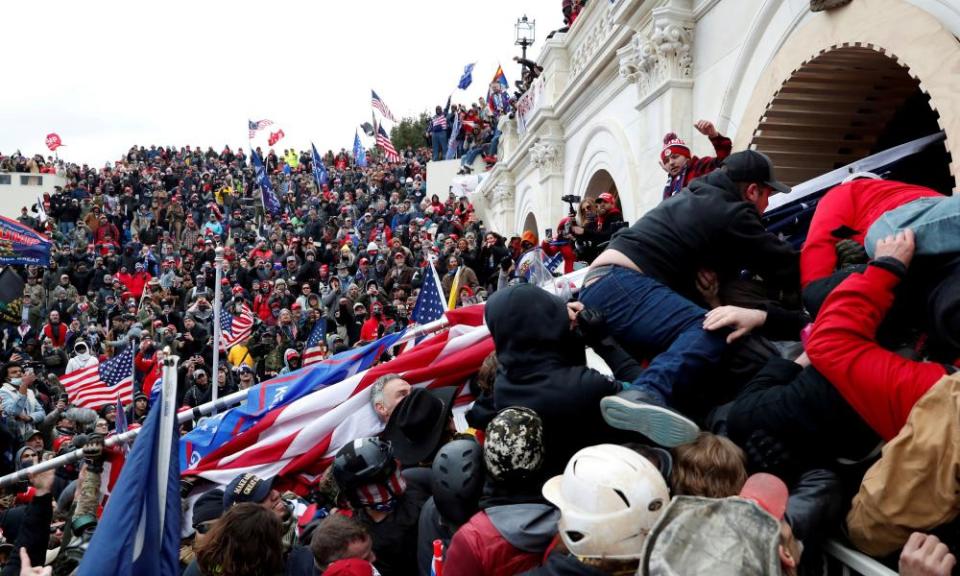
The broader issue was race. The protesters in the summer were largely Black, infuriated by repeated police killings of unarmed Black civilians. The mob which stormed the Capitol was almost entirely white.
Efforts to build a concerted government response to the growing white supremacist terrorist threat had been stymied for years in the absence of political will and money. The warning signs along the road to Wednesday’s attempted putsch, the dress-rehearsal occupations of state capitols and a foiled plot to kidnap the Michigan governor, not to mention the activities of the Proud Boys and other far-right factions, were mostly ignored.
The heedlessness was hardly surprising given that the commander-in-chief was leading the calls for sedition. He responded to extremist rallies against Democratic governors by tweeting out encouragement for his followers to “liberate” those states.
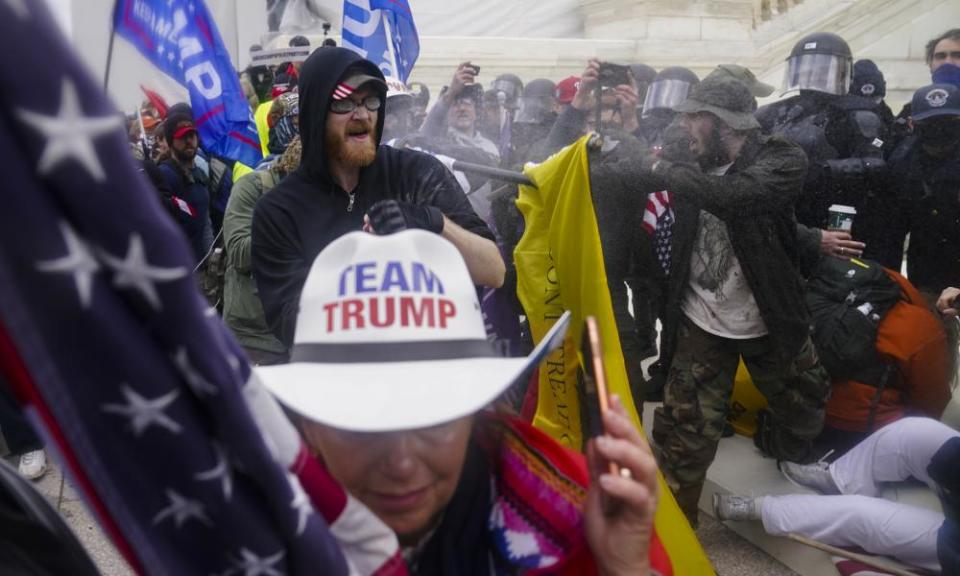
In his effort to somehow upend his resounding defeat in November, he summoned the faithful by Twitter for a “StopTheSteal” rally to reverse the result. “Be there, will be wild!” he promised.
Tens of thousands answered the call from around the country. Some drove all night, in part to avoid the price of a hotel. Some, like Texan real estate broker Jenna Ryan, arrived on a private jet with a group of friends, saying she was on the way to “storm the Capitol”.
Ryan later posed with a smile and a V-for-victory hand sign in front of the smashed windows of the Capitol building and declared it “one of the best days of my life”. After a wave of condemnation, she issued a statement saying she did not condone violence and was “truly heartbroken for the people who have lost their lives”.
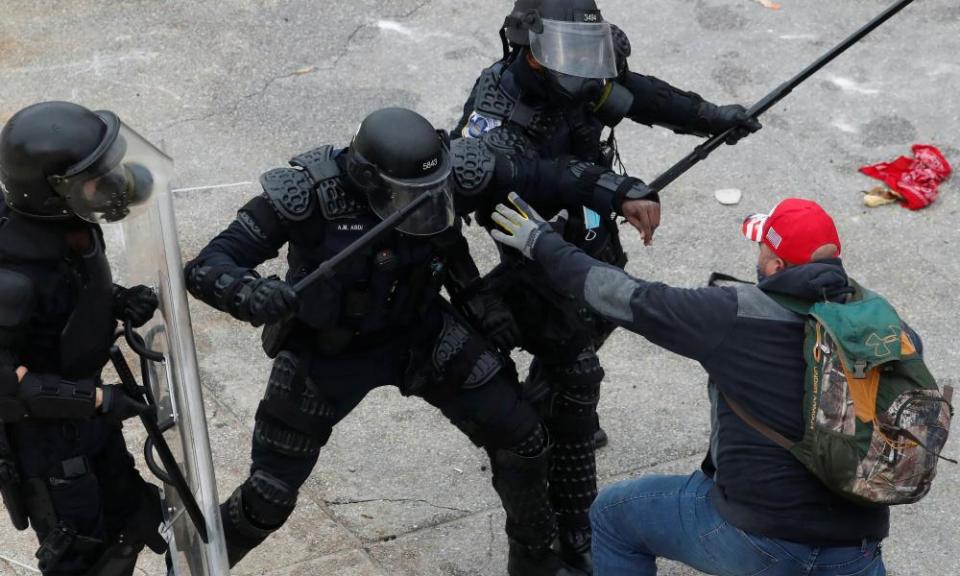
The crowd that converged under the giant needle of the Washington Monument was a carnival mix of red-hatted Maga aficionados, men dressed like commandos, and a sprinkling of apocalyptic cults. A pair of women in scarves held yellow signs saying “Women belong in the kitchen” and ”Fake Christians Go to Hell”. Over the years, Trump has built a broad church for the aggrieved, for which the only doctrinal requirement has been loyalty to its high priest.
Thousands of people filled one side of the mound under the monument and spilled on to Constitutional Avenue across from the Ellipse, an oval park in front of the White House where a stage had been set up, protected by bulletproof glass.
The choice of music on the sound system seemed deliberately melancholic, including Elton John’s Funeral for a Friend, the My Heart Will Go On theme from Titanic, and In the End, by Linkin Park, in which the repeated refrain is: “I tried so hard and got so far. But in the end it doesn’t even matter.”
The tempo picked up with the Village People’s Macho Man to introduce the warm-up act, 76-year-old Trump attorney Rudy Giuliani, who called for the election to be resolved through “trial by combat”.
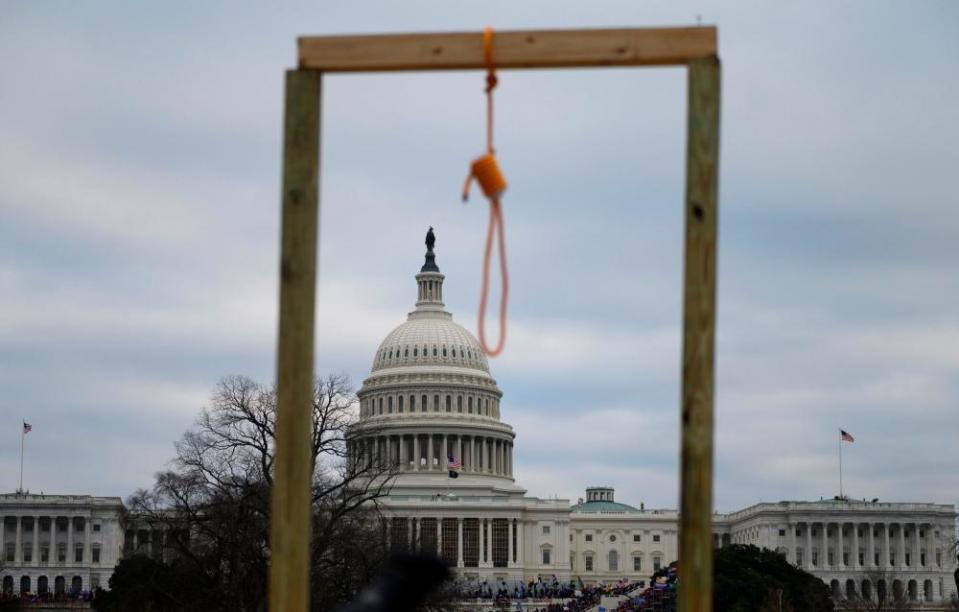
A smartphone video of the Donald Trump Jr filmed inside the marquee backstage showed him and his girlfriend, Kimberly Guilfoyle, giddy with excitement. Guilfoyle breaks into a hip-thrusting dance and then shouts into the camera: “Have the courage to do the right thing! Fight!”
Trump’s 74-minute speech began close to noon, and was a grab-bag of familiar resentments against the media (the “enemy of the people”), Democrats, “weak Republicans” and his latest target, his own deputy, Mike Pence, who had minutes earlier declared to Congress he had no power to reverse the election result.
“We’re going to have to fight much harder and Mike Pence is going to have to come through for us,” Trump declared. “If he doesn’t, that will be a sad day for our country.”
He told the thousands of people before him to march down Pennsylvania Avenue the mile and a half to the Capitol, to put pressure on Congress “peacefully and patriotically”. But in an address that used the words “fight” and “fighting” 20 times, from the mouth of a leader who had consistently winked at violence by his followers, it had the weight of a caveat tacked on as an afterthought.
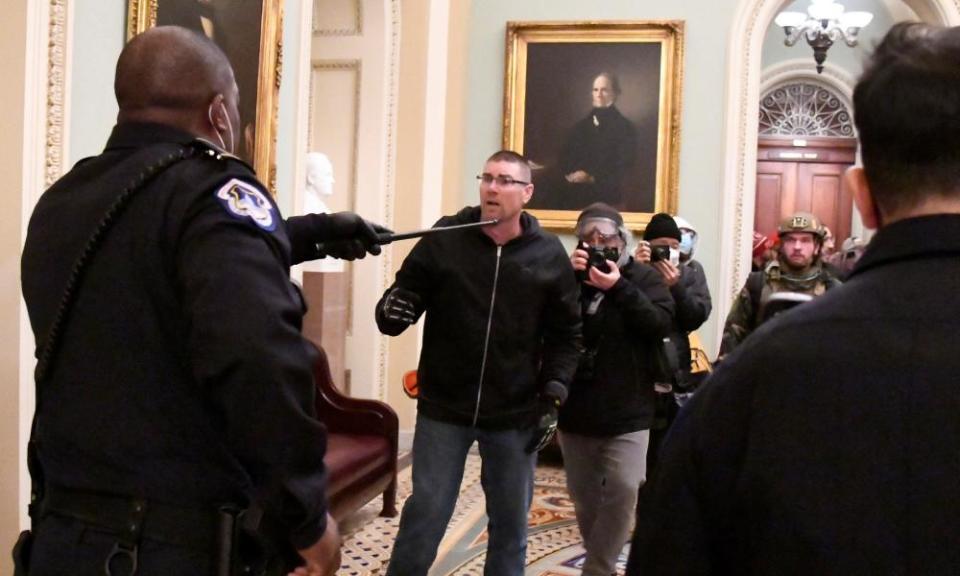
The crowd was certainly primed for conflict, after years of hyperbole and demonisation of enemies by their leader, who had convinced them he was their solitary hope in a looming existential struggle.
Kasey Botelho, a young woman from Rhode Island sitting under one of Washington’s many cherry trees with her boyfriend Mike, speculated on what would happen if Congress did not bend to the president’s will.
“Honestly, I’m not 100% sure, because the supreme court failed us. I think Trump’s only option he really has left is to call military action into it because he has the right to do that,” she said. “I think we’ve waited enough and dealt with enough shit … to go through with it, get it over with.”
Jacobb Lake, a contractor who had driven overnight with his teenage son from Joplin, Missouri, was standing on Constitution Avenue with a handmade sign bearing the insignia of the QAnon conspiracy theory subculture, and declaring “My vote is not for sale. This will not be forgotten.”
He had an even more dire prediction than Botelho for America’s future if the effort to overturn the election failed, and Biden took office.
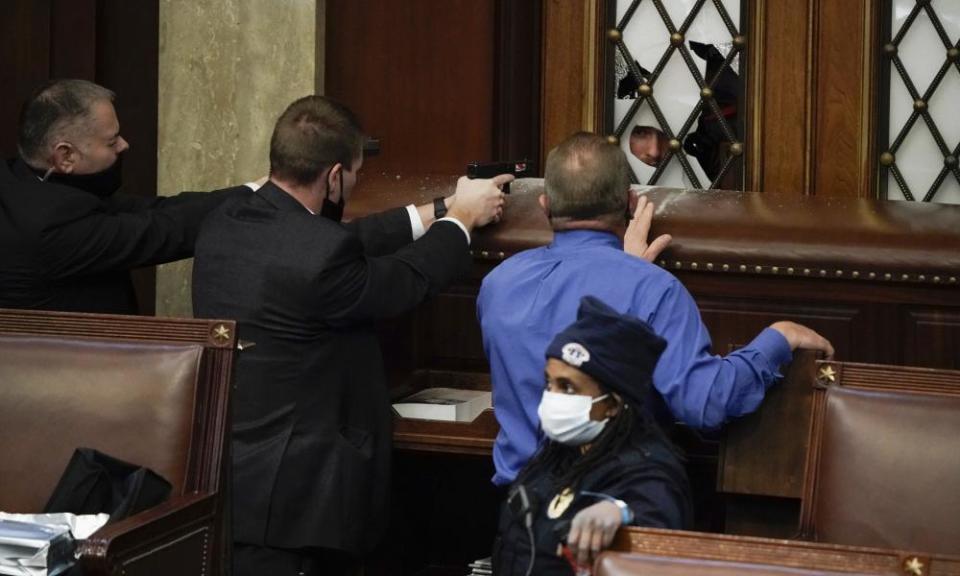
“World war three,” Lake said, adding that the nation “might split up”.
Trump had said he would accompany his supporters to the Capitol but as soon as he finished speaking, he left in his motorcade for the 100-metre drive back to the White House.
Some of the crowd peeled away and scattered across the city, but many thousands made their way across the lawns of the National Mall heading eastwards towards Congress.
By that time, the day had already taken on a much darker hue. Two pipe bombs had been found at Republican and Democratic party offices near Congress and the assault on the Capitol had begun. Those who had gathered there in the morning were a harder-edged crowd than the Ellipse – more male with a lot more paramilitary gear. Someone had hung a rope noose on a frame on the Capitol grounds, and the vocabulary was noticeably more violent.
“I heard at least three different rioters at the Capitol say that they hoped to find Vice-President Mike Pence and execute him by hanging him from a Capitol Hill tree as a traitor,” Jim Bourg, news pictures editor in Reuters’ Washington bureau, recalled on Twitter. “It was a common line being repeated. Many more were just talking about how the [vice-president] should be executed.”

Some of the gathering mob turned on journalists, demanding to know their affiliation, and in several cases attacking them. Some were thrown to the ground, and one photographer was thrown off a low wall.
As it became clear they would not be fired upon, the attackers gained in confidence. A few scaled a wall up to a terrace and then used scaffolding to climb higher still, where they could start smashing windows. By 2pm, they were inside the building.
Members of Congress had been holding a joint session in the House of Representatives chamber to certify the electoral college results – something that was a half-hour formality in normal times but which had been prolonged by the objections from Trump loyalists.
Vice-President Pence, in the chair for the session, was abruptly whisked out of the room by his security detail and a security officer strode into the centre of the chamber to declare an emergency. Plainclothes officers rammed a wooden chest against the main door to the chamber and drew their pistols.

Senators and representatives in the well of the chamber were ushered out of a back exit, while members and press in the gallery were told to duck down and don the gas masks kept in bags under each seat. Lisa Blunt Rochester, Democratic representative from Delaware, began to pray out loud for “peace in the land, peace in this country … right now in the name of Jesus … Protect America.”
The tiled corridors outside the chamber were filling up with insurrectionists. Some police officers kept up efforts to contain them, while others simply gave up and even waved them through. At least one policeman was caught on camera taking a selfie with an insurgent.
One man unfurled a Confederate flag, a reminder that the US had its own long history of political violence which has snaked above and below the surface for decades and was now strutting unashamed in broad daylight in the heart of political power.
Finding the main door to the House chamber blocked, a group of rioters found their way to a side entrance, smashing the glass out of the doors leading to the Speaker’s Lobby.

First through the breach was Ashli Bobbitt, a 35-year-old air force veteran from San Diego. She had once been an Obama supporter but during the Trump era, had been drawn into a parallel culture of QAnon conspiracy theories. Wearing a Trump flag around her waist and a Stars and Stripes backpack, video footage shows her climbing through the damaged wooden door, ignoring the shouted orders from inside to retreat, when a plainclothes police officer emerged from an office on the other side and shot her once in the neck. She fell backwards on to the floor and died, soon afterwards at about 2.45pm, illuminated by the mobile phones of other rioters filming her last moments.

Elsewhere in the building a Capitol police officer, Brian Sicknick, was fatally injured in a melee with rioters, reportedly by being attacked with a fire extinguisher. He died of his wounds on Thursday night. Three other people died of “medical emergencies” in the course of the breach, at least one of them from a heart attack, bringing the full death toll to five.
Back in the White House, the president and his aides were transfixed by the unprecedented scenes they could see on their television screens. The Washington Post cited an aide as saying Trump was “bemused” by the spectacle. He saw the rioters as fighting for his cause but found them aesthetically distasteful and “low-class”.
According to this account, the president was characteristically focused on his own grievances: that Pence had betrayed him, and that his followers were being judged more harshly than the anti-Trump demonstrators in the summer. He refused to condemn his own people, despite the desperate pleas from his erstwhile allies on Capitol Hill to call off the assailants.
When Trump was finally persuaded to send a calming presidential message, it was on his terms. He began by repeating his groundless claim that he was the victim of a fraudulent election. He told people to go home but added: “We love you; you’re very special.”
Witnesses said he was oblivious to the gravity of what had occurred: the five deaths, the unprecedented violation of Congress, the irrevocable damage to America’s reputation and the very real possibility his vice-president could have been lynched in response to Trump’s vilification.
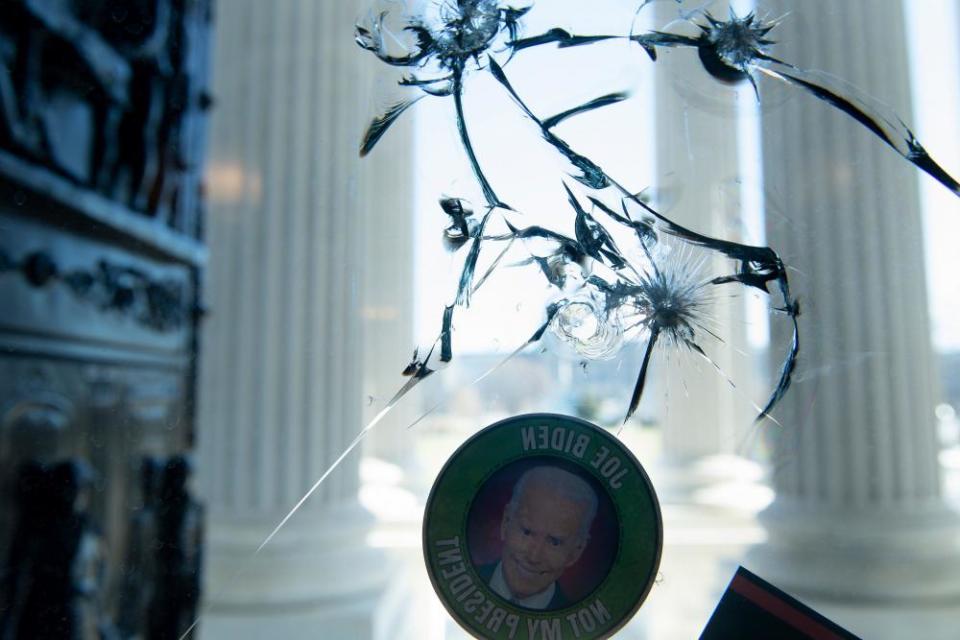
It was only after White House counsel, Pat Cipillone, made clear to Trump the extent of his legal liability for the storming of the Capitol, that Trump adjusted his tone in a second video on Thursday night, finally conceding defeat in the election two months earlier, and denouncing the insurrection.
By then, the backlash had already begun. Congress had certified the result, his congressional supporters were being shunned by fellow Republicans, Facebook and then Twitter banned him indefinitely and Democrats prepared for a second impeachment, likely to begin this coming week.
The Trump era is not quite over, however. There are still 10 days of this presidency left, and reports from the Oval Office suggest he no longer feels chastened, regretting having agreed to an orderly transition. He has flatly refused to attend his successor’s inauguration on 20 January. No one who knows Trump is betting he will now just slink quietly out of the back door of history.

